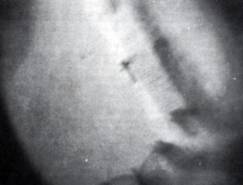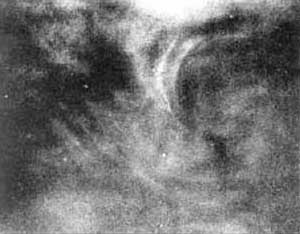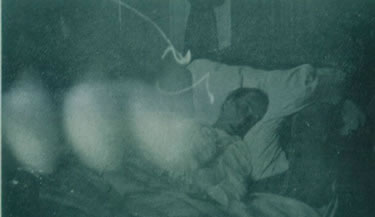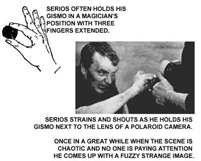


 |
 |
 |
click on the images to see them larger
Here is a
fragment of a larger work, some of which I used in lecture/performance.
20.8.2006 Berlin, Opening of Normalnull.
I want to talk about mistake , misunderstanding and misdirection as forms of
inspiration and practical direction in performance. The refusal to except an
agreement about how the world works and the purpose that human beings have in
invention. changing the polarity of cause and effect.
Ted Serios was a drunk with behavioural problems. Anti social and mildly psychotic
. The made images in cameras without subjects or light. Half naked and angry,
screaming into sealed box, crashing around the room. Since his death a faked
technique has been shown to produce the same pictures, but not under the same
circumstances , and some still claim Serios was the real thing. Truth may be
in the performance not in the stated result. Fakery might be a pure language
in its action , if not in its intent.
In each session he held a numbered series of sealed Polaroid Land cameras. point
blank to his head and violently shunted the pitched images from his grey mind
into the sulking wet film, he reversed the hunger of photography and re-established
a believe about the camera that is older than its invention. Serios, an out
of work bell hop and professional low- life, like so many others mediums, prophets
and severely haunted was driven by a pure Dionysion energy that convinced various
groups of investigators that he could think pictures. With the aid of his "gizmo"
a small condom like tube made of cardboard and cellophane,set over the lens
,he strained the shadow images without light into physical being. During these
performances he would curse and shout, his body would erupt with flushes and
insect like stings. There is such a passionate fakery here it makes the incident
totally genuine in its need to exist and registrars a high mark on one of the
most unclean side roads of the art. Its history is packed with smoke ghosts,
gauze plasma's and trapped souls, why do they find it so comfortable to live
here?


I suggest then there is a deep sub shadow imbedded in the photographic process.
An integral contradiction to its mechanised proclamation of objectivity.
And that its true comparison is not to our visual sense but to our temporal
anxiety. Its component parts seem available to this suggestion. Glass is trusted
both to focus a and in early days relieve the picture, Glass itself is transient,
our vision is tuned to a material which is a fluid that agrees to behave as
a solid. This odd protean mass of burnt sand is both gate and pen in the optical
field of inverted causeways. When added to a mould of minerals which are reliant
on temperature to register stillness, it suggest an unstable but magical alliance.
The camera is a hutch, an umbered trace nest, an incubation place. closer to
to the womb than the head [1]This shared expectation with any other spinctered
receptacle offers a major key to its identity and purpose.
It is constructed to celebrate and intensify waiting.The true prey of the machine
is not light but time. Later photographers have deluded themselves that their
purpose is to record the world' this is a sad arrogance and a technical misunderstanding.
Light can be measured by time, time cannot be measured by light. Film is forensic
in that it crudely demonstrates that an event has occurred; this is equally
true in bubble chamber or Instamatic. Any photograph, when viewed constantly
contains a powerful charge of melancholy. This strange emotion is not a composite,
but an essence, it is an instinctive barometer to the flux of time.The viewers
sense of distant loss is a response to the retreating moment, haloed around
the single image.
(This is why the feeling does not occur in cinema.)The subject is immaterial,
pictures of people often calm the shock by misdirecting the focus and substituting
a possible narrative or an anchor of association.
The uncanny sense of displacement is most felt in photos of landscape, interiors
and objects. The first camera devises shared some of this sensation setting
the exterior, live world aside, holding it tabled for our observation and need.
In the camera Lucida it is less blatant, its practice slavery of controlled
image is modestly sensible ,giving a small but intimate link between the users
hand and the distant subject. The camera obscurer is very different it shows
us the root base in the emotional enigmas of cameras in that detachment and
watching are amplified in a distant light, the viewer is allowed to see while
being hidden, to taste the silent separation of their position of power.
This voyeur engine is not only the mechanical ancestor of photography but the
propagator of the strangeness in its meaning. There is more, something about
the manipulation and projection of light itself is felt to be mysterious. We
have all become entranced in a dark room by the single sunbeam of light that
projects miniature clouds moving against the wall through some small unnoticed
aperture, Something that vibrates an uncanny membrane between our interior and
exterior sense of existence.
The dark room itself is a confused sanctum, a cave where e blood warm fluids
are consulted under red light, a carefully locked pre-birth chamber where elements
of transient and permanence are exchanged.
Photography and clinical psychology were born at the same time and shared a
fast and abnormal development. Their paths dramatically crossed at the clinic
of Salpetriere in the late 1890's Charcot's theatre of hysteria was informing
and entertaining rank's of the curious. Artists, scientists and writers were
spellbound by its pathos, its sexuality and the apparent clarity of its understanding.
Photography was deemed to be the ideal means to contain and record the named
catalogues of malady. Its practical application was supported by it superficial
but sympathetic kinship to Mesmerism ( which had never truly gone away,) indeed
much of the parathenalier was very alike.


While documenting patients it became notices by some that an almost therapeutic
effect was occurring. A calming focus for the deranged.
Perhaps it might be possible to siphon off the madness, to collect it like light,
to process the very essence of malady. Some went even further, one of Charcot's
colleagues a Dr. Baraduc had photographed his son holding a dead pheasant. When
processed it appeared veiled. Baraduc eliminated light sources or accident that
may have produced these defects on the plates. He began to speculate on another
possibility, he described the shrouding effect thus; The veil of life of the
spirit is an invocation, a reversal of the time icon, a reinvention of the time
icon discovered through the phenomena of photography. For him this explained
many things, especially the secrets of the Turin shroud, which crops up again
and again in this study of metaphoric cameras. Baraduc states; The shroud far
from being an imprint of the body, is an emanation from afar through time, an
imprint of the spirit. It was time that made these revelation possible, the
length of exposed time. The experiments with children continued, he found that
by scaring them he could obtain a different kind of veil; "a luminous cloth
like knitting with knots and chains". After experimenting with more hysterical
children he decided that visible external light was superfluous. He set his
camera above t he bed of a sleeping abbot and caught a black cloud , the aura
of his nightmare.
He started to collate an entire photographic iconography of the aura; Willpower--pearly
dots, Energy--vertical lines, Receptivity--white horizontal lines etc. Baraduc
went beyond Ted Serious and gave up the camera altogether, holding up plates
to the foreheads of his subject in total darkness.
He then like so many since went in search of ghosts. It was rumoured that Balzac
and Nader were still haunting Paris. The spectre of Nader was even kind enough
to sign his ghost image. After photographing dead people for days on end, he
started to make self portraits, becoming more and more hysterical and delirious
in the presence of his own spectre.
His experiments were written of by contemporaries as dubious dabblings with
developing fluids. But his legacy to spirit photography went on , haunting and
irritating any dignified stance of objectivity.


Brian Catling Normalnull
Projekt
Brian Catling Biographie
Brian Catling Normalnull
Person
Normalnull